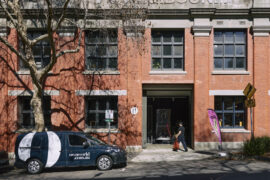As the Senior Brand & Communications Manager of Siemens, Roberto Finamore knows a thing or two about how technology is transforming our homes.
For most of us, what we want from our appliances is simple: reliable, fuss-free performance that delivers every time. In many ways, designing the perfect appliance for the contemporary age of living is a balancing act: it should harness complex technology without handing control over to the computer; it should be trend-conscious but not transient; it should have multiple features without being overwhelming. Few companies are able to strike this balance as deftly and consistently as Siemens, who have supported generations of homemakers around the world in their day-to-day cooking and living. We spoke to Roberto Finamore, Senior Brand & Communications Manager of Siemens to learn what the future holds for smart appliances.

Roberto Finamore, Senior Brand & Communications Manager of Siemens
Indesign: Siemens remains a distinctly Germanic company, with a strong brand history and design philosophy coloured by German design traditions. What do you believe gives Siemens products a distinctly German feel and appeal?
Roberto Finamore: There is something delightfully functional about German design, and this shines through in the Siemens fleet of home appliances. From an objective point of view, the understated elements, the linear perfection, the preference for overall harmony over standout forms are all trademarks of German design you’ll clearly find in Siemens.
But these have been hallmarks of other design movements, too. The German sensibility is essentially that the design of any particular form always be en-route to how a given task or function can be optimally performed. In other words, excellent design works toward achieving outstanding functionality, not alongside it.
Siemens is one of Germany’s most trusted and popular design brands. How do you see its growing appeal internationally affecting the way Siemens’ newest products are being designed?
The core mission of Siemens can be roughly translated to “progress in the service of mankind”. This is as true for home appliances as it is in the many other sectors in which Siemens operates. Part of the Siemens vision is a mission to bring technology that improves people lives in as many homes as possible. Today, the growing footprint of Siemens around the world reinforces its longstanding design focus.
In terms of technological and design innovation, Siemens has remained a definite front-runner. What do you believe are some of the more exciting developments occurring within this space?
Siemens is making great strides in connectivity and the smart home, a movement that is sure to accelerate over the next several years. The pursuit of automation and intelligent machinery has always been in the Siemens DNA. For example, in today’s Siemens home you can find ventilation that automatically adjusts its intensity according to what is being cooked, smart ovens that remove all the guesswork from baking, and washing machines that remove odours from suit jackets at home without using a single drop of water.
Another development that bridges functionality and design is the Siemens induction cooktop with integrated ventilation, which combines extraction and induction in an all-in-one cooking surface. Doing away with the need for a traditional rangehood, the cooktop opens up the possibility of a cooking island with no overhead joinery.
From a pure design point of view, the idea of the kitchen as a centrepiece of the home is enhanced by the distinctive Siemens aesthetic, which most people would readily describe as ‘sleek’. Siemens understands modern kitchens like almost no other brand – look at any well designed kitchen and you’ll find a Siemens appliance is never far away.
What is particularly unique about the Siemens approach to innovating appliance technology and product design?
The Siemens view of the world is inherently progressive. Rather than take a nostalgic view of cooking and the home, Siemens seamlessly integrates technology and product design into people’s lives to allow for more expansive experiences. A Siemens oven can now cook a sophisticated meal – say a whole snapper or roast – in up to half the usual time, leaving more time for recreation. Heading out to a movie or concert after dinner doesn’t have to mean a B-grade meal. It’s about fitting more into life, rather than ‘saving time’.
As our homes are increasingly smarter, where does Siemens see itself going in the near future in terms of product design and the types of new questions your product designers need to answer?
The “connected home” is already being incorporated into the Siemens product fleet, many of which already feature WiFi connectivity. Our infrastructure around that connectivity – that is, the useful stuff you can actually do with it – is being rolled out globally right now. In one way, we already know where connectivity can enhance the user experience, be it in product error diagnostics, extensive recipe libraries that talk to the oven, or connectivity with online suppliers to automatically replenish washing and dishwashing additives. But like all leaps in technology, the end user will ultimately tell us what adds real value to their lives, and what are simply solutions looking for problems. As that feedback comes in, Siemens will apply its user-centric design response and continue its lead in this area.
One of the most interesting aspects of Siemens’ products (from my perspective) is the degree to which they are so obviously influenced by architectural forms and developments. Is an architectural, sculptural design aesthetic something that you believe is central to the Siemens identity?
I can’t speak on behalf of the personal influences on our product designers, but I’ve always perceived consistent Bauhaus principles coming through. There is no doubt that Siemens has progressed significantly from making machines that cook and clean and adopted a whole-of-kitchen viewpoint on range design. By definition, this requires us to understand broad trends in architecture and kitchen interiors, and ensure that the design lines and finishing materials are sympathetic to the surrounding structures and surfaces. The Siemens preference for basic geometric shapes and avoidance of organic structures works beautifully when juxtaposed against earthy surfaces like timber veneer or stone. That’s what gives Siemens such a classic, enduring quality. It absolutely works.
The experience and user interface is something that is obviously very central to the Siemens design philosophy. But how, in particular, would you characterise Siemens’ approach to augmenting the experience, pleasure and efficiency of your products?
The user experience is a big part of the Siemens design brief and we are often recognised as leaders in this area. Our approach is simple: the inside of our products are increasingly complex, but so too are smartphones, home audio systems, and cars, to name a few. Consumers who look for the latest in those areas are also typically the ones considering Siemens when it comes to their home, so they expect that our technologies are supremely easy to command and a delight to use.
The overriding characteristic of a Siemens user interface is that they place the user in complete command, even if that means only touching the appliance two or three times throughout a cooking or washing session. Control doesn’t necessarily mean constantly calibrating an oven or a cooktop. As our appliances become ever more automated and multi-functional, users need to be updated in a clear and concise way so that they have confidence that the appliance is doing exactly what it should.
INDESIGN is on instagram
Follow @indesignlive
A searchable and comprehensive guide for specifying leading products and their suppliers
Keep up to date with the latest and greatest from our industry BFF's!

The undeniable thread connecting Herman Miller and Knoll’s design legacies across the decades now finds its profound physical embodiment at MillerKnoll’s new Design Yard Archives.

London-based design duo Raw Edges have joined forces with Established & Sons and Tongue & Groove to introduce Wall to Wall – a hand-stained, “living collection” that transforms parquet flooring into a canvas of colour, pattern, and possibility.

Rebecca Wright, Principal at Plus Architecture, weighs in on the innovative nine-day fortnight work model, shedding light on its impact on work-life balance and productivity.

Gerald Matthews of Matthews Architects provides insight on South Australia’s 2024 Future Living code amendment, focusing on co-located living.
The internet never sleeps! Here's the stuff you might have missed

Abbotsford Convent has appointed Kennedy Nolan to guide the next stage of development at the heritage-listed Melbourne precinct, continuing its evolution as a cultural and community landmark.

ownworld unveiled Silent Beams in its Collingwood showroom, marking the arrival of Swedish lighting brand Wästberg through a new partnership with Euroluce.